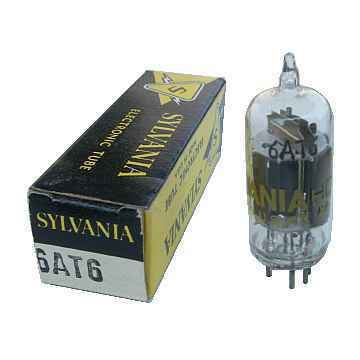 | ||
Sylvania electric products
Sylvania Electric Products was a U.S. manufacturer of diverse electrical equipment, including at various times radio transceivers, vacuum tubes, semiconductors, and mainframe computers. They were one of the companies involved in the development of the COBOL programming language.
Contents
History
The Hygrade Sylvania Corporation was formed when NILCO, Sylvania and Hygrade Lamp Company merged into one company in 1931. In 1939, Hygrade Sylvania started preliminary research on fluorescent technology, and later that year, demonstrated the first linear, or tubular, fluorescent lamp. It was featured at the 1939 New York World's Fair.
Sylvania was also a manufacturer of both vacuum tubes and transistors.
In 1942, the company changed its name to Sylvania Electric Products Inc. (note no comma)
In 1959, Sylvania Electronics merged with General Telephone to form General Telephone and Electronics (GTE)
Through merger and acquisitions, the Company became a significant, but never dominating supplier of electrical distribution equipment, including transformers and switchgear, residential and commercial load centers and breakers, pushbuttons, indicator lights and other hard-wired devices. All were manufactured and distributed under the brand name GTE Sylvania, with the name Challenger used for its light commercial and residential product lines.
GTE Sylvania contributed to the technological advancement of electrical distribution products in the late 1970s with several interesting product features. At the time, they were the leading supplier of vacuum cast coil transformers, manufactured in their Hampton, Virginia plant. Their transformers featured aluminum primary winding and were cast using relatively inexpensive molds, allowing them to produce cast coil transformers in a variety of KVA capacities, primary and secondary voltages and physical coil sizes, including low profile coils for mining and other specialty applications. They also developed the first medium voltage 3 phase panel that could survive a dead short across two phases. Their patented design used bus bar encapsulated in a thin coating of epoxy and then bolted together across all three phases, using special non-conductive fittings.
By 1981 GTE had made the decision to exit the electrical distribution equipment market and began selling off its product lines and manufacturing facilities. The Challenger line, mostly manufactured at the time in Jackson, Mississippi was sold to a former officer of GTE, who used the Challenger name as the name of his new company. Challenger flourished, and was eventually sold to Westinghouse, and later Eaton Corporation. By the mid 1980s, the GTE Sylvania electrical equipment product line and name was no more.
In 1993 GTE exited the lighting business to concentrate on its core telecomms operations. The European, Asian and Latin American operations are now under the ownership of Havells Sylvania. With the acquisition of the North American division by Osram GmbH in January 1993 Osram Sylvania Inc. was established.
Brand name
In the early 1980s, GTE Sylvania sold the rights to the name Sylvania and Philco for use on consumer electronics equipment only, to the Netherlands' NV Philips. This marked the end of Sylvania's TV production in Batavia, New York, USA, and Smithfield, North Carolina, USA. The Sylvania Smithfield plant later became Channel Master. The rights to the Sylvania name in many countries are held by the U.S. subsidiary of the German company Osram. The Sylvania brand name is owned worldwide, apart from Australia, Canada, Mexico, Thailand, New Zealand, Puerto Rico and the USA, by Havells Sylvania, headquartered in London.
Osram Sylvania
Osram Sylvania manufactures and markets a wide range of lighting products for homes, business, and vehicles and holds a leading share of the North American lighting market [2]. In fiscal year 2008, the company achieved sales of about 1.75 billion euros, which comprises 38% of total Osram sales. It employs about 10,000 people in North America and is headquartered in Danvers, Massachusetts, north of Boston. Most of the company's products are marketed in North and South America under the SYLVANIA or OSRAM brand name.
Advertising
Accidents
The Sylvania Electric Products explosion is a well-known industrial accident which occurred 1956 at their Bayside, New York City facility.
